Trusted Tables is in Scotland, the land of unicorns, whiskey, haggis, neeps and tatties!
Explore Scottish gin and food. Plus 2 easy recipes for Scottish favorites Cullen Skink (a delicious fish chowder) and shortbread.
“Life is but a day at most.”, said Robert Burns, the famous Scottish poet. I agree. It’s way too hot in Miami, and I am off, exploring food and drink in other places.
Stop #1. Edinburgh, Scotland.
Kicking off non-Miami Trusted Tables is a visit to Scotland, the land of fairies and scaries and forbidding castles and dreich. (That’s Scottish for cold, dreary and wet.)
The weather alternates between rain and gray; the sun peaks out occasionally. Yet who can dislike a country known for beer, whiskey and gin and whose national animal is the unicorn – a beast so powerful and fast, yet so pure and innocent, only Kings and Virgin Maidens can keep them.
Weird factoid: Marco Polo proclaimed to the world he saw real, honest-to-God unicorns while exploring the Sumatra islands. They were, he claimed, “nearly as big as wild animals” and more brutish and ugly than was commonly thought. Yet, he proclaimed, they exist.
Not so fast, M.P. It turns out what you saw was rhinocerous, not a unicorn.
Here in Edinburgh, unicorns are everywhere. On top of buildings, as logos on clothes, and on the wall of pubs. It’s a national obsession, along with whiskey, beer, fish, haggis, the scars of many wars and deep fried Mars bars.
Beyond the unicorns, this old city has a young vibe. From a food perspective, almost anything is available. Italian, French, Thai, Chinese, you name it. Every menu, from grab-and-go to pubs to fine dining places - offers vegetarian and vegan options.
Yet traditional Scottish food is clearly the predominant offering in the touristic part of the city. Cows, sheep and fish are abundant, so it’s a meat, potatoes food culture. Salads are hard to come by. Pubs and coffee shops are everywhere and traditional Scottish food is hardy (remember the weather!). It’s frequently made from inexpensive cuts of meat and inexpensive root vegetables.
Historically, the city was walled, crowded and incredibly poor, so those foods fit the bill economically as well as financially. And food traditions evolve remarkably slowly. (I’m looking at you, turkey on Thanksgiving.)
Cooking class with Nell Nelson, Edinburgh Food Safari
Wanting to go beyond restaurants to explore the traditional Scottish delights, I took a cooking class at the home of the amazing Nell Nelson. Nell is a an enterprising, creative, charismatic food writer and traveler who runs an Airbnb, leads walking tours and runs cooking classes out of her home in the New Town part of Edinburgh.
Factoid #2: New Town is older than Old Town. The Scots have a sense of humor.
Nell’s home is in what Bostonians would call a brownstone. Here’s a feel for her house and us cooking:
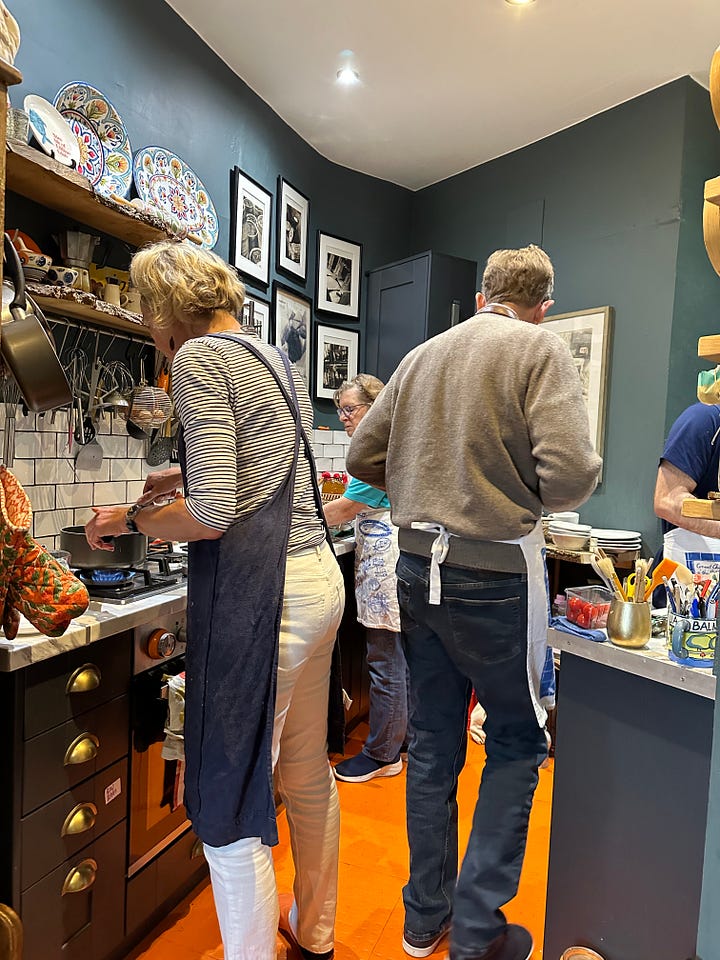

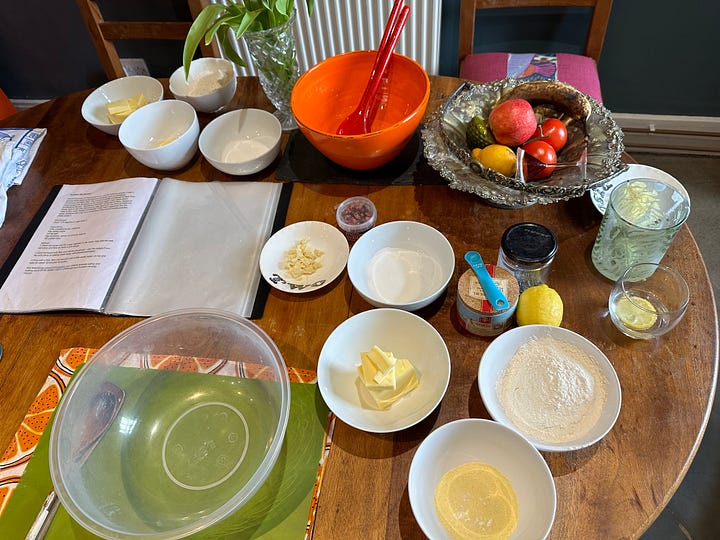
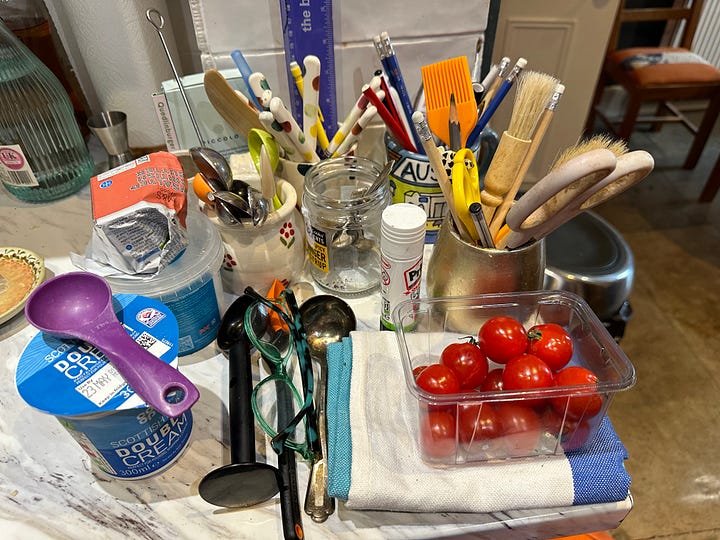
We had classic Burns night specialities: haggis, neeps and tatties.
Thee national Scottish bard is Robert Burns, the guy who famously asked you to “take a cup of kindness yet, for auld lang syne.” January 25 is Burns Night and Scotland feasts on Gin and Tonics, fish soup, haggis, needs and tattes, and shortbread. We had the same feast in May. And so can you. It’s easy to make, delicious and just fun.
Lind & Lime Dry Gin, an Edinburgh specialty
We launched our meal with a gin and tonic and oak/cheese cookies. The gin was Lind & Lime, a local distillery in Leith (a part of Edinburgh).
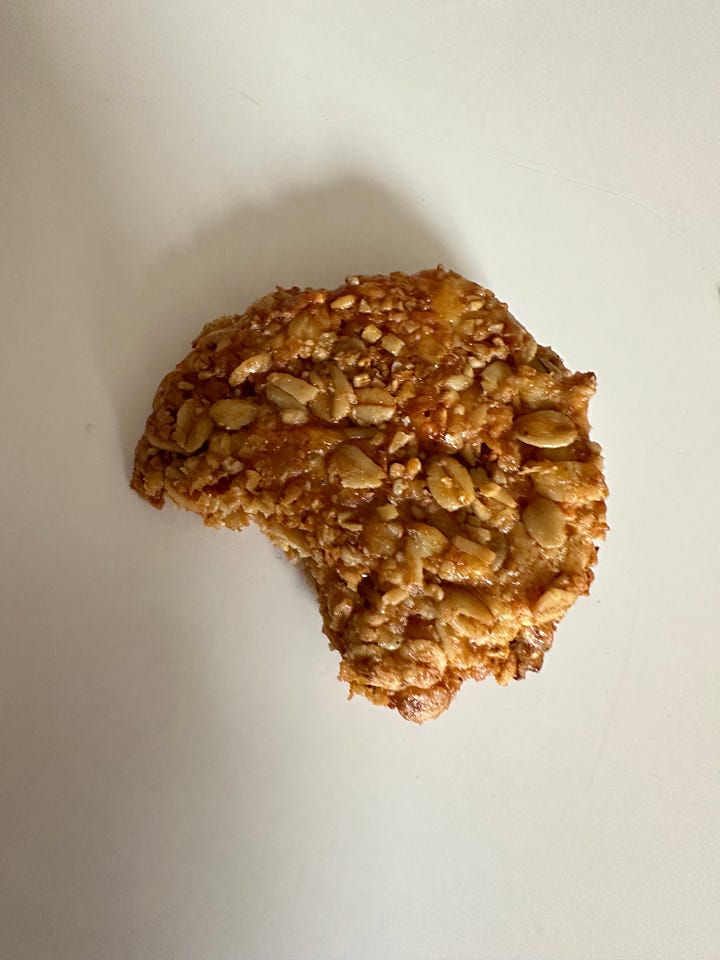
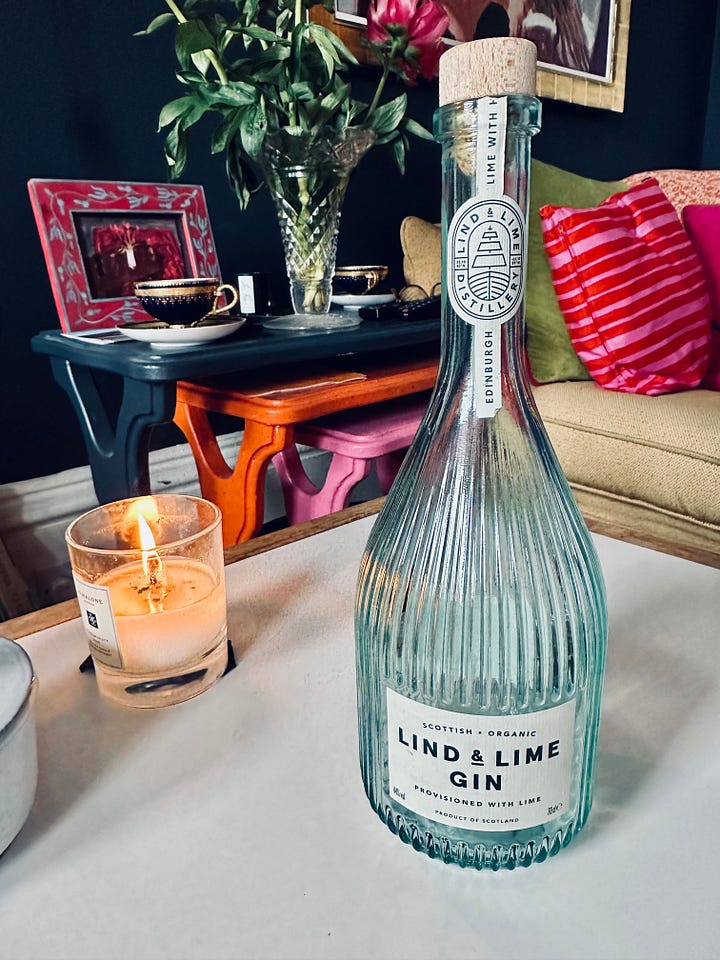
Lind & Lime makes London Dry Gin and only London Dry Gin. London Dry Gin is a legal designation. It means the gin is made from juniper berries, botanicals and, importantly, no added sugar. The botanicals in Lind & Lime are coriander, angelica (a musky, sweet, carrot like root), liquorice, orris (the root of an iris and commonly used in gin production), fresh lime peel and pink peppercorns. It’s also in a very cool and re-usable bottle. I plan to buy this gin (and the cool bottle) when I get home.
If you want to get a little more insight into how to ensure your summer G&Ts are suberb, my Substack colleague, Peter Suderman explains how to make a great one.
As for the meal we (sort of) prepared, the menu was Cullen skink, haggis, and short bread, complimented by Jura whiskey. Here’s a primer on these foods.
Haggis, explained.
Haggis is made by butchers, not home cooks. In other words, it’s a “don’t try this at home” kind of food. It’s made from diced/ground awful offal (innards, stomachs, livers, lungs of animals). The basic ingredients are diced small and mixed with oatmeal and spices seasonings. It’s traditionally served with mashed potatoes and squash (known as neeps and tatties) but is now found on top of pizzas, beside morning scrambled eggs, an addition to a burger, or stuffed in poultry. It literally tastes like the essence of meat.
We had a vegetarian version of haggis, neeps and tatties served as a terrine of sorts. It was comfort food, filling and rather bland. The vegetarian version is made from things like carrots and onion and oatmeal and spices.
All well and good and vaguely interesting. But what I really want to share with you is the two delicious foods we made that anyone can quickly and easily duplicate at home: Cullen Skink and short bread cookies.
Cullen Skink is a delicious fish chowder that is easy to make.
(The Scots do have a way with words, don’t they?)
Cullen Skink is a fish chowder. Cullen is a town. A skink is a lizard but it is also Scottish for knuckle. The soup was originally made from beef shins and knuckles but then beef got too expensive so people started using smoked haddock instead. The Scottish language is very fanciful. J.D. Rowlings had a lot to work with!
Here’s how to make it:
Dice a leek and a 4 small waxy potatoes very small and cook in butter and water until soft.
While softening the vegies, cook ¾ pound of a smoked fish (smoked haddock is used in Scotland) in 2 cups of milk. The goal here is to gently simmer the mixture to infuse the milk with the smokey fishy flavor.
We accidentally boiled ours. It made our soup taste a little more intense than the version that didn’t boil over. So, in other words, if a mistake happens, make lemonade!
When the veggies are done, combine the ingredients with 4 tablespoons cream, some salt and pepper and parsley and lemon to taste.
So simple. So delicious. So Scottish. Makes 4 small servings or 2 hearty ones.
How to make authentic Scottish shortbread, the preferred sweet of the (sadly beheaded) Mary Queen of Scots.
I love the simplicity of shortbread cookies and have always been afraid of making them. Like producing flakey pie crusts, it just seems hard. But I learned from Nell that shortbread is easy and foolproof to make.
We have the infamous and beheaded Mary Queen of Scots to thank for these fabulous cookies. Because they are made of butter, they were expensive in her day and only enjoyed by the wealthy. She loved them and they spread to her court and followers and into the population.
Factoid #3: while shortbreads are more cookie than bread, they were called bread to avoid the tax on cookies.
Ingredients:
5 oz room temp butter
¼ c sugar
1 cup flower
¼ cup seminola (give it a slightly crunchy texture)
1/4 teaspoon salt
Work the butter and sugar together until it is creamy and the lumps are out. Takes 4 – 5 minutes by hand.
Add salt, flour and seminola. Mix well; use your hands!
Add any extra flavorings you chose. (We added lemon zest and lavender to half and white chocolate to the other half.
Roll it like a big fat sausage (maybe 1/1/4” diameter) with your hands, then slice it into pieces about ¼” thick. Prick the tops to aerate. We also decorated some of them with tiny little rose petals.
Place in the frig until the butter hardens.
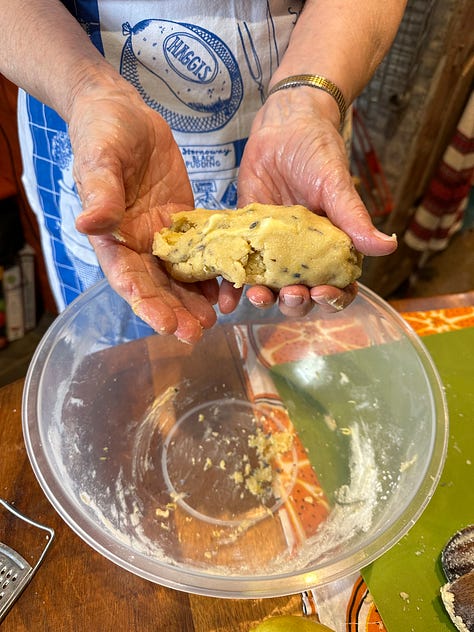
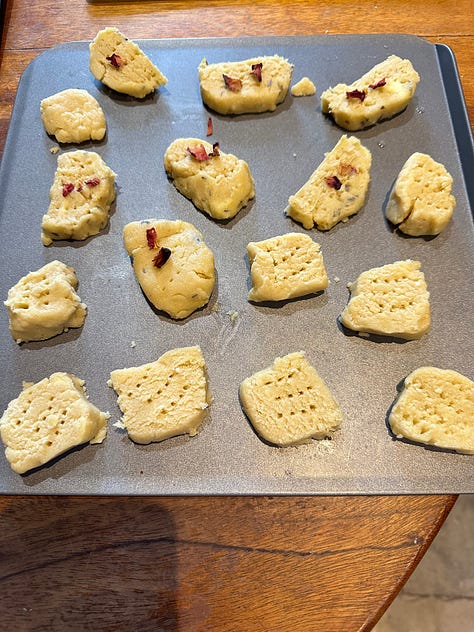
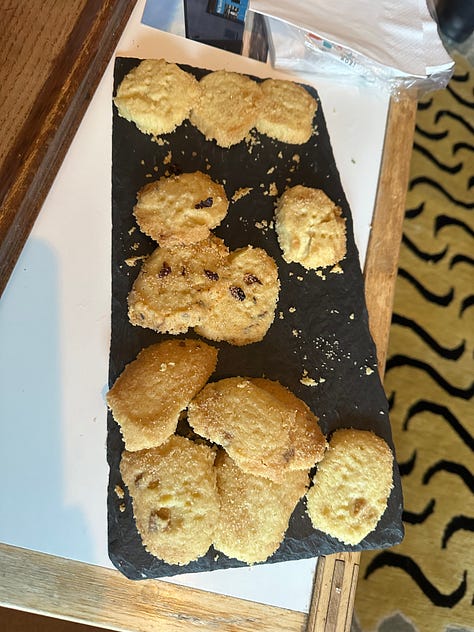
Bake in pre-heated 350 degree oven for about 10 minutes. This is the hardest part. Watch carefully! They can burn quickly.
Here we are enjoying the meal that you, too, can enjoy at home!
Thanks for reading Chapter 1 of Trusted Tables in Scotland.
Press comment below to tell me what you think.
And if you enjoy reading Trusted Tables, please subscribe!
Thank you!
Anne


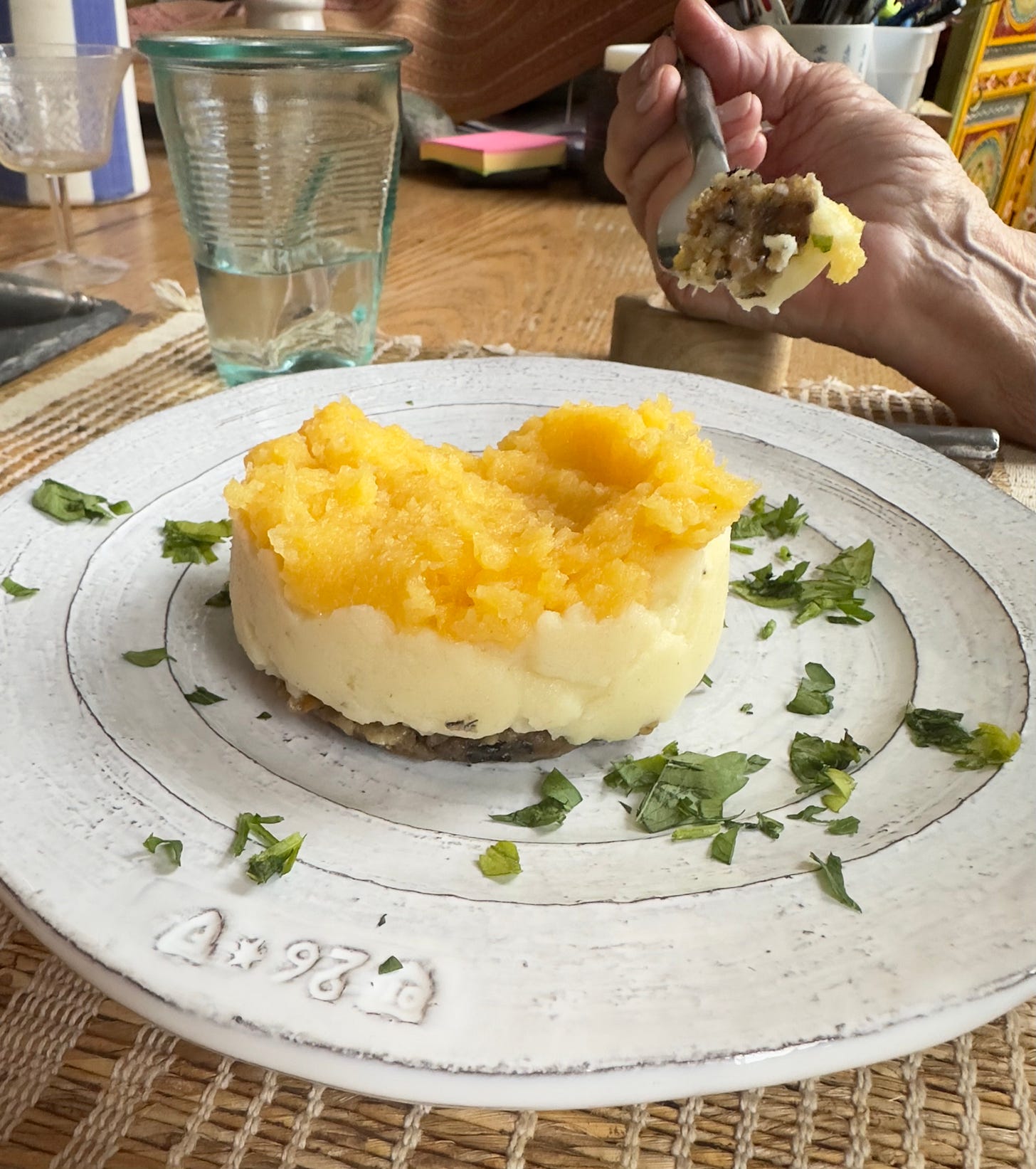

I love your writing and I feel like I’m right beside you on your adventures.
Fabulous !!! So enjoyed reading this, Anne. Thanks.